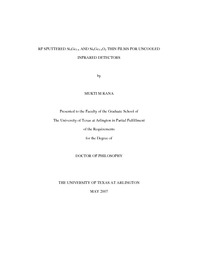
ATTENTION: The works hosted here are being migrated to a new repository that will consolidate resources, improve discoverability, and better show UTA's research impact on the global community. We will update authors as the migration progresses. Please see MavMatrix for more information.
Show simple item record
| dc.contributor.author | Rana, Mukti M | en_US |
| dc.date.accessioned | 2007-08-23T01:56:32Z | |
| dc.date.available | 2007-08-23T01:56:32Z | |
| dc.date.issued | 2007-08-23T01:56:32Z | |
| dc.date.submitted | March 2007 | en_US |
| dc.identifier.other | DISS-1634 | en_US |
| dc.identifier.uri | http://hdl.handle.net/10106/348 | |
| dc.description.abstract | The objective of this work is to find a suitable combination of radio frequency (RF) sputtered SixGe1-x and SixGe1-xOy thin films for uncooled infrared detection. Thus, fabricating and characterizing microbolometers with SixGe1-x and SixGe1-xOy thin films as the sensing material are the ultimate goal of this work.
Thin films of SixGe1-x and SixGe1-xOy were deposited by RF magnetron sputtering at room temperature from a single target of SixGe1-x in Ar or Ar : O2 environment. The silicon and oxygen concentrations were varied in a parametric investigation of the dependence of the electrical and optical characteristics of the thin films on composition. As Si concentration was increased in the Si1-xGex films, the temperature coefficient of resistance (TCR) was decreased. For Si1-xGexOy films, the addition of oxygen to the Si1-xGex, increased the activation energy, TCR, normalized Hooge coefficient for 1/f-noise, optical bandgap, and transmittance while the reflectance remained almost constant.
Microbolometers of doped SixGe1-x were fabricated and characterized. A TCR of 1.25%/K with a device resistance of 41.4 KΩ was achieved. Thermal conductivity was found to be 1 × 10-5 WK-1 for these doped SixGe1-x microbolometers. The presence of high 1/f-noise was observed which caused to degrade bolometers performance.
Uncooled SixGe1-xOy microbolometers were fabricated and passivated by forming gas at 250 0C for different interval of time to reduce noise. The value of normalized Hooge coefficient for 1/f-noise (Kf) was decreased from 7.54 × 10-7 to 2.21×10-10 after 8 hours of forming gas passivation performed at 250 0C. The highest responsivity and detectivity obtained from SixGe1-xOy:H microbolometers were 1.05 × 103 (V/W) and 8.27 × 106 (cm-Hz1/2/W) respectively while the room temperature TCR was -4.80%/K. The lowest thermal conductivity was found to be 4 × 10-8 WK-1.
Cavity based tunable Fabry-Perot microspectrometer was fabricated using bulk micromachining technology. The device was fabricated by using Al2O3 as the support layers for both top and bottom part of the cavity. Al was used as the mirror and electrode materials. Polyimide was used as the sacrificial layer to form the cavity. The device is still under test to measure its performance. | en_US |
| dc.description.sponsorship | Butler, Ronald | en_US |
| dc.language.iso | EN | en_US |
| dc.publisher | Electrical Engineering | en_US |
| dc.title | RF Sputtered SixGe1-x and SixGe1-xOy Thin Films For Uncooled Infrared Detectors | en_US |
| dc.type | Ph.D. | en_US |
| dc.contributor.committeeChair | Butler, Donald | en_US |
| dc.degree.department | Electrical Engineering | en_US |
| dc.degree.discipline | Electrical Engineering | en_US |
| dc.degree.grantor | University of Texas at Arlington | en_US |
| dc.degree.level | doctoral | en_US |
| dc.degree.name | Ph.D. | en_US |
Files in this item
- Name:
- umi-uta-1634.pdf
- Size:
- 7.500Mb
- Format:
- PDF
This item appears in the following Collection(s)
Show simple item record


